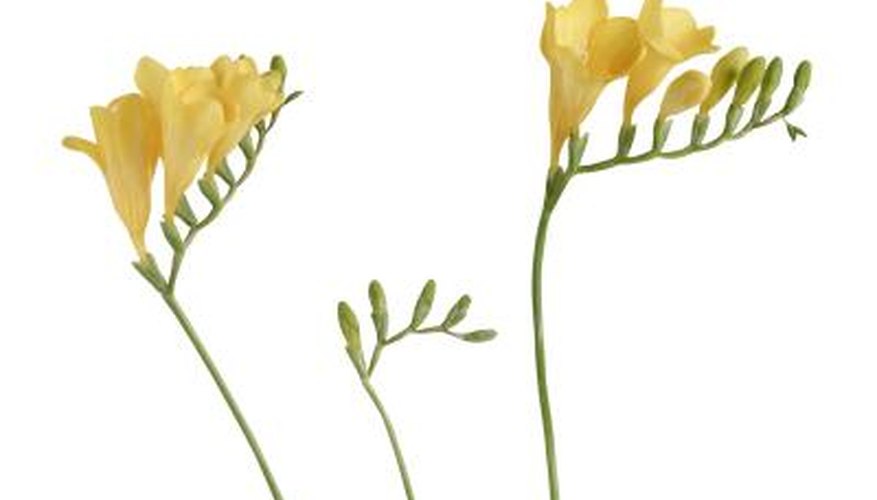The common name of plants can vary by region --- for example, what some people call a "marsh marigold," other people call a "cowslip" --- so plants are also assigned scientific names to eliminate ambiguity and correctly identify individual species. Because scientific names are based on Latin words, it is sometimes referred to as the "Latin name" of the plant. The scientific name is made up of a genus name, which refers to a group of closely related plants with similar characteristics, and a species name to pinpoint just one variety. The common name freesia is used to describe a favourite garden flower, but "Freesia" is only the genus name, and there are actually many different species of freesia in the world.
Origin
The genus Freesia is named after F.H.T. Freese, a 19th century physician from Germany. Freesia grows wild in Africa, and two species, Freesia corymbosa and F. caryophyllacea, were cultivated in Europe in 1766. European botanists continued naming and cultivating freesia species throughout the 19th century, and, according to Alice Notten from the Kirstenbosch National Botanical Garden in South Africa, there are now 16 recognised species of freesia.
- The genus Freesia is named after F.H.T.
- Freese, a 19th century physician from Germany.
- European botanists continued naming and cultivating freesia species throughout the 19th century, and, according to Alice Notten from the Kirstenbosch National Botanical Garden in South Africa, there are now 16 recognised species of freesia.
Freesia Alba
One of the most common species of freesia is F. alba. In Latin, the word "alba" means "white," and F. alba have pure white petals with a dash of yellow. They also sometimes have a hint of lavender in the unopened bud and a small purple streak deep in the throat. F. alba is highly fragrant and will naturalise in gardens in warm climates like California.
- One of the most common species of freesia is F. alba.
- In Latin, the word "alba" means "white," and F. alba have pure white petals with a dash of yellow.
Other Species
F. grandiflora has scarlet-red blossoms with a darker red centre. "Grandiflora" translates from Latin to mean "large flowered." F. viridis, whose species name means "green" in Latin, has greenish yellow flowers with thin petals. F. laxa comes in shades of red or pink flowers, with some hybrids coming in blue or white. "Laxa" translates from Latin to mean loose and may refer to the species more open growth habit.
- F. grandiflora has scarlet-red blossoms with a darker red centre. "
- F. viridis, whose species name means "green" in Latin, has greenish yellow flowers with thin petals.
Freesia Care
Because they originated from Africa, freesia require a hot climate and can take little to no frost. They are generally considered hardy to USDA zone 9. If you're in a cooler climate, you can grow freesia in containers, or you could plant the bulbs in the spring and dig them up in the fall to store them in a dry, dark place. Freesia grows best in acidic, well-drained sandy soil and prefers morning sun and afternoon shade. Water freesia weekly. If you grow freesia in the garden, you may need to protect the bulbs from moles and other rodents. Freesia is pollinated by bees, and in the right location will self-seed and spread throughout your garden.
- Because they originated from Africa, freesia require a hot climate and can take little to no frost.
- If you grow freesia in the garden, you may need to protect the bulbs from moles and other rodents.
